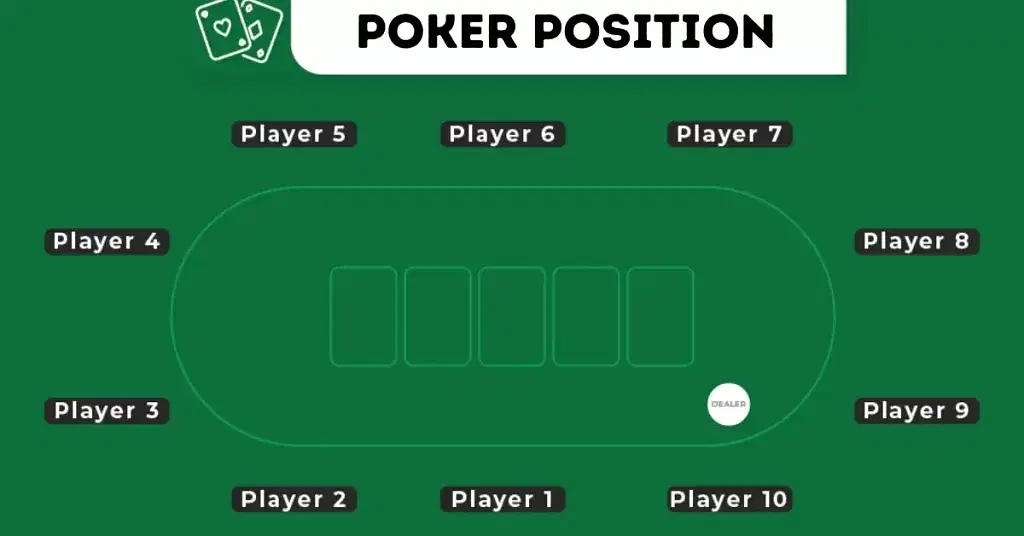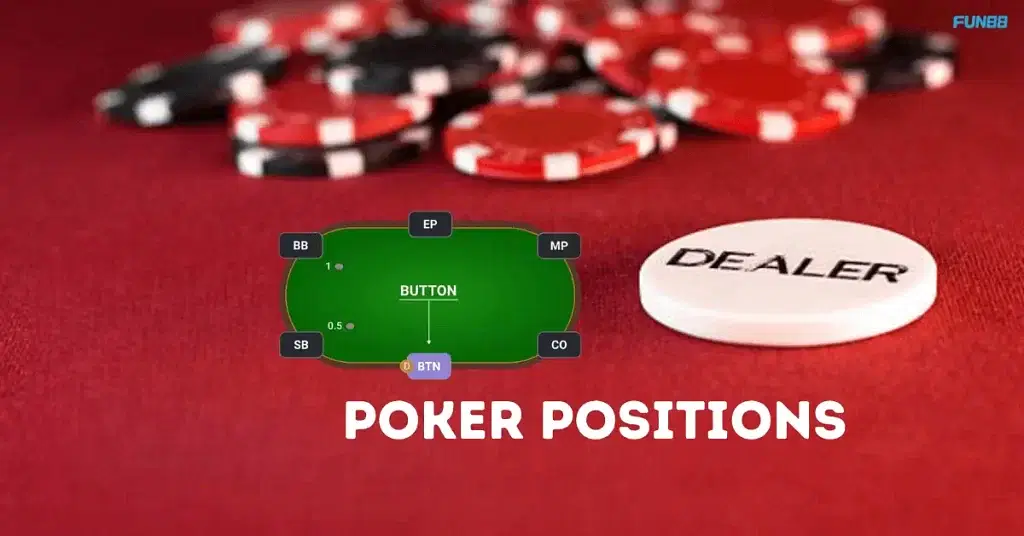Regarding Poker positions, the quest is not just about playing cards; it’s about playing them with finesse and strategic insight. Consider this your comprehensive guide to understanding and mastering the positional play, catering specifically to the Indian context of the game.
Why Poker Positions Matter
Where you’re seated or in your Poker position, it can greatly influence your strategy and success. Whether you’re under the gun, sitting pretty at the button, or somewhere in between, each position offers unique opportunities and challenges.
But why is understanding your position so crucial? Simply put, Poker is a game of information. Being in a favourable position allows you to gather more information about your opponents’ actions before you need to make your move. Better information leads to better decisions, which in turn leads to more pots won. Who wouldn’t want that?
An Overview of Poker Positions
Before we delve into strategies, let’s get familiar with the basic Poker positions:
- Early Positions (EP): Often referred to as being “under the gun” (UTG), these are the first positions to act in a round. Here, you’ll have limited information about other players’ intentions, so it requires a conservative and tight playing strategy.
- Middle Positions (MP): These sit snugly between the early and late positions. You will have seen some players act, so you have slightly more information. It’s a sweet spot, allowing for a more flexible approach.
- Late Positions (LP): This includes the cutoff and the button. Players here have the most advantageous view, seeing almost all opponents’ actions before it’s their turn. It’s a golden chance to make most of the weaker hands.
- Blinds: With the small blind (SB) and big blind (BB), these positions are unique because the players must post forced bets. Playing from the blinds requires special tactical considerations.

Here’s how to navigate smoothly:
- Focus on Premium Hands: Due to limited information, stick to strong hands like high pairs and suited connectors to avoid unnecessary risks.
- Play Tight: Conservative play is advantageous. It allows you to maintain chips for later rounds, where you might be in a better position to dominate.
- Observe Opponents: Pay close attention to betting patterns and body language. Even if you’re not in a round, observing early on can pay dividends later.
Through this conservative outlook, you’re ensuring that each move you make in the early position is backed by a strong hand, mitigating risks and enhancing your strategic play.
Related Read: 10 Expert Tips to Become a Poker Expert: Level Up Your Skills
Middle Positions: Balancing Act
Middle positions offer a balanced approach, giving you a mix of information and positional power. Here, you can widen your range a bit:
- Expand Your Range: From middle positions, you can include mid-range pairs and Ace-Queen, Ace-Jack type hands. The flexibility here lies in adapting your range based on previous players’ actions.
- Aggressive Play: If players have shown weakness before you, don’t shy away from an aggressive strategy. This is your chance to assert dominance.
- Discretion in Bluffing: Poker Bluffing can be more effective with a few players yet to act. However, always have a clear plan and contingency in mind.
The middle position is about balance. It’s about leveraging the bit of extra information you have while preparing for late-position plays or defending against aggressive opponents from late positions.
Dominating from Late Positions: Commanding the Table
This is where strategic play truly flourishes:
- Open Your Range: You are in the driver’s seat and can afford to open up your play to include speculative hands.
- Steal the Blinds: In Poker, fortune often favours the brave. From the cutoff or button, you can attempt blind steals, especially if the blinds have shown passive behaviour.
- Use Positional Awareness: Watch how players act earlier—this effectively guides your defensive or aggressive strategy.
Being last to act means you’ve gathered maximum information. Use this power wisely to control the pot size depending on your hand strength and opponents’ tendencies.
Also Read: 3 Card Poker Rules: Everything You Need to Know
Blinds: Playing Smart from Defense to Offense
Playing from the blinds is a definable art form. On the one hand, you are compelled to invest in chips even with a poor hand. But with the right tactics, you can turn this into an advantage:
- Big Blind Defense: Often, others will try to steal the blinds. Defend your big blind smartly — play back aggressively if facing a steal attempt, especially against players who often seek to capitalise on your forced bet.
- Small Blind Traps: The small blind may start the round on a weaker note, but don’t miss the opportunity to set traps or make timely steals.
- Post-Flop Challenges: Position post-flop can be challenging from the blinds, but intelligent analysis can navigate tricky waters. It’s crucial to read the board and adjust your strategy fast.
Poker blinds are a defensive front but provide avenues for counter-attack and opportunistic pot captures when played smartly.
Poker Positions Strategy: Adapting and Overcoming

Now that you’re familiar with the anatomy of Poker positions, it’s imperative to understand that strategy is dynamic. Poker is a living beast — its spirit thrives on adaptation. Here are core tactics to enrich your strategy across the board:
- Observation is Key: Always be the observer, even when not in play. Opponents’ betting patterns — frequency of continuation bets, aggression levels, and hand strength indicators are windows into their strategy.
- Flexibility in Play Style: While a tight-aggressive strategy often dominates, variance and unpredictability can throw opponents off balance. Adjust your play style to be different when needed.
- Effective Bluffing: Mastering the Bluff is a Poker artist’s palette. Utilise Poker positions to time your bluffs effectively. Bluff less in early positions, save the surprise for when the moment arrives in later positions.
- Pot Odds and Equity: Calculate pot equity in alignment with positional play — knowing the odds of winning relative to pot odds can be the deciding factor in complex rounds.
Incorporating these dynamic strategies ensures adaptability, enabling you to manipulate Poker positions to dictate the pace of the game.
Also Read: What is 3-Bet in Poker: How and When to Use It?
Final Thoughts
This journey through the intricacies of Poker positions has, we hope, offered you insights not just into specific strategies but also into the mindset needed for mastery at the Poker table. In the end, it’s not just about the cards you’re dealt but how you play them — applying positional strength with strategic wisdom.
Remember, every game is a new story. As you apply these tactics, consider lessons from your heritage, where skilful strategy and patience have long been the keys to winnings. Now, it’s over to you to utilise these elements, get onto the felt, and transform those strategic insights into winning moves.
Frequently Asked Questions (FAQs) about Poker Positions
Understanding table layout is key. The dealer’s position is your primary reference. Positions rotate clockwise on each hand. Visualise your seat relative to the dealer to identify if you’re in early, middle, or late positions or one of the blinds.
Position often offers insight into opponents’ intentions, which is crucial in decision-making. With advantageous seating, players can bluff effectively, control pot size, and exploit opponents’ weaknesses, sometimes making positional advantage outweigh the strength of one’s hand.
Absolutely! New players should focus on understanding positions to make informed decisions. Even with minimal experience, recognising when to play conservatively or aggressively based on position enhances strategic play and builds foundational skills.
Strategic betting depends heavily on position. Late positions allow for informed betting after observing opponents, enabling opportunistic raises. Early positions, conversely, necessitate cautious and tight play, demanding stronger hands and forethought.
Indeed, bluffing excels from late positions. Observing your opponents’ actions lets you gauge the optimal moments to apply pressure. However, bluff wisely – recognise when opponents are likely to fold or challenge.
Position can significantly impact tournament play, where chip management is crucial. Strategic use of position aids in both chip preservation and accumulation, adapting to shifts in dynamics and enabling progress deep into the tournament rounds.
Star it if you find it helpful.

